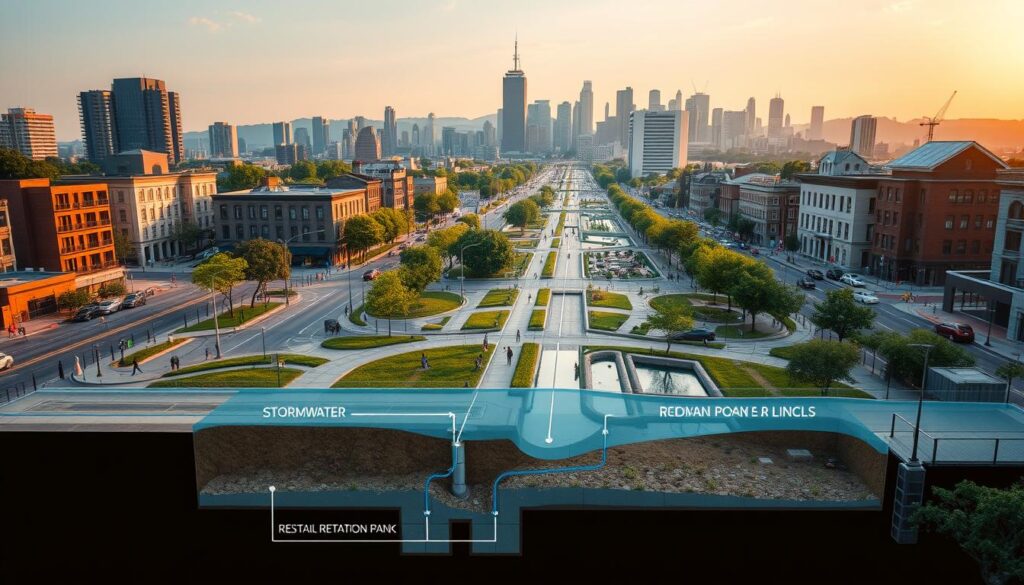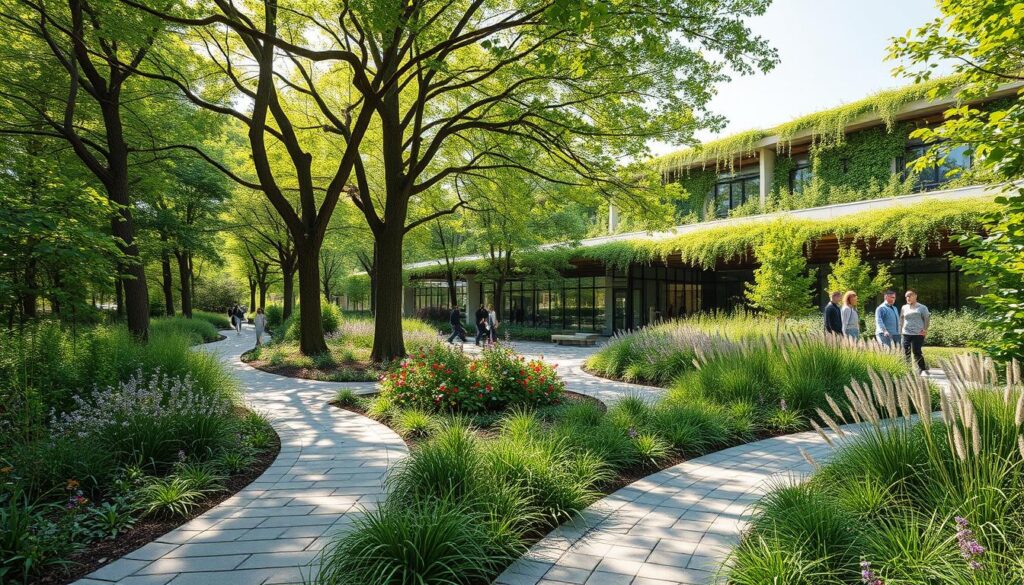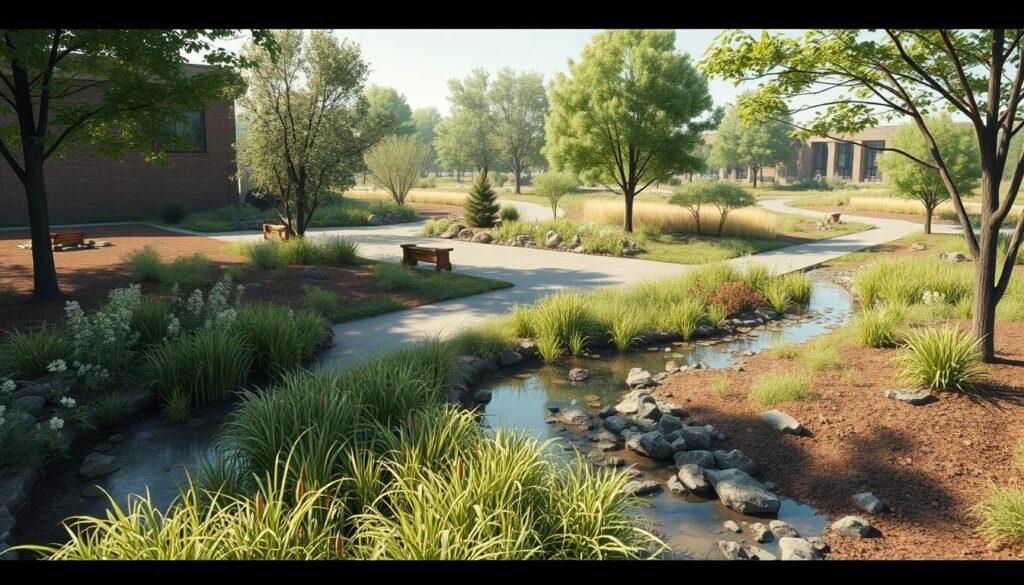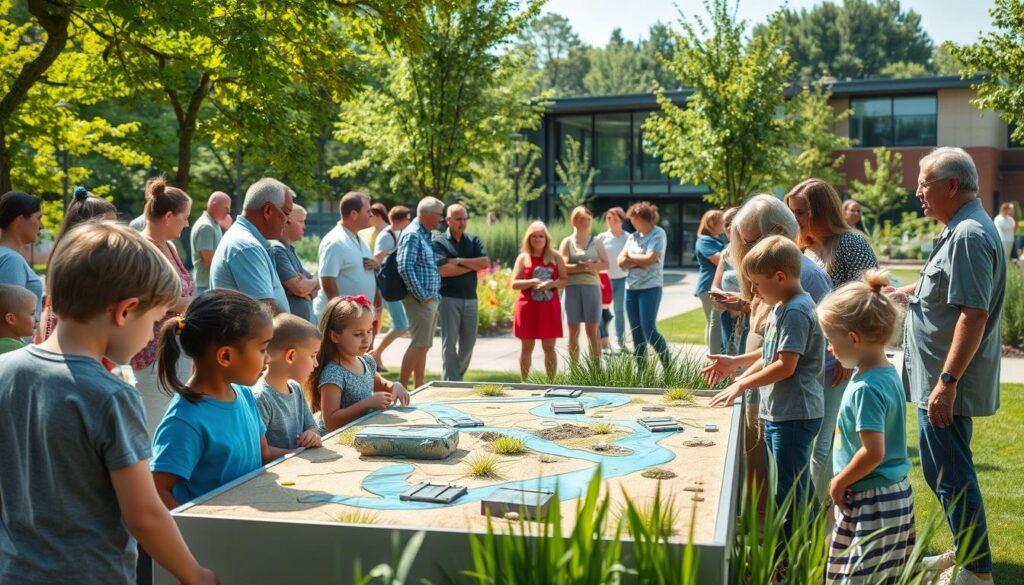Urbanization poses significant challenges to effective stormwater management, including increased flooding and water pollution. However, with the advent of smart management systems like SmartSWM, it’s now possible to enhance the efficiency of stormwater systems. According to recent studies, smart stormwater controls can significantly reduce downstream flooding and pollution by optimizing the release of stored water in advance of forecasted precipitation events. Advanced technologies in smart stormwater management are revolutionizing the way we approach urban water challenges.
By leveraging forecast data and integrating it with the behavior of Smart Ponds, more efficient management practices can be achieved. This not only mitigates the impacts of urbanization but also provides numerous benefits, including water quality improvements and flood mitigation.
Key Takeaways
- Efficient stormwater management is crucial for mitigating urbanization impacts.
- Smart stormwater controls can significantly reduce downstream flooding and pollution.
- Advanced technologies like SmartSWM enhance the efficiency of stormwater systems.
- Integration of forecast data with Smart Ponds improves management practices.
- Sustainable stormwater solutions provide numerous benefits, including water quality improvements.
Understanding Stormwater Management Design
Understanding the principles of stormwater management design is essential for creating sustainable urban environments. As urbanization continues to grow, the need for effective stormwater management becomes increasingly important.
What is Stormwater Management?
Stormwater management refers to the process of controlling and utilizing rainwater runoff to prevent flooding, reduce pollution, and protect water resources. It involves a range of techniques, including green infrastructure design and low impact development design, to manage stormwater effectively.
“Effective stormwater management is not just about mitigating flood risks; it’s also about improving water quality and enhancing urban ecosystems,” says an expert in the field.
Importance of Effective Design
Effective stormwater management design is crucial for several reasons. Firstly, it helps to reduce the risk of flooding by controlling the flow of rainwater. Secondly, it improves water quality by filtering out pollutants and sediments. Lastly, well-designed stormwater management systems can enhance urban aesthetics and provide habitats for wildlife.
- Reduces flood risk
- Improves water quality
- Enhances urban ecosystems
Common Challenges in Stormwater Management
Despite its importance, stormwater management faces several challenges, including aging infrastructure, climate change, and urbanization. These challenges necessitate innovative solutions and adaptive management strategies.
For instance, incorporating green infrastructure such as permeable pavements and green roofs can help mitigate some of these challenges.
| Challenge | Solution |
|---|---|
| Aging Infrastructure | Retrofitting with green infrastructure |
| Climate Change | Adaptive management strategies |
Key Principles of Stormwater Management Design
The key to successful stormwater management lies in its design principles. Effective stormwater management design is crucial for maintaining urban environmental health and mitigating the impacts of urbanization on water bodies.
Water Quality Control
Water quality control is a fundamental aspect of stormwater management. It involves implementing measures to reduce pollutants in stormwater runoff. Best Management Practices (BMPs) such as sedimentation ponds and filtration systems can significantly improve water quality.
Some effective strategies for water quality control include:
- Implementing sediment basins to capture sediment and pollutants
- Using vegetated swales to filter stormwater
- Employing permeable pavements to reduce runoff
Flood Prevention Strategies
Flood prevention is another critical component of stormwater management design. Strategies to prevent flooding include the use of detention ponds, levees, and floodwalls. These measures help to manage stormwater runoff and prevent damage to urban infrastructure.
| Flood Prevention Measure | Description | Benefits |
|---|---|---|
| Detention Ponds | Temporary storage of stormwater runoff | Reduces peak flow rates, preventing downstream flooding |
| Levees and Floodwalls | Barriers to prevent floodwaters from inundating urban areas | Protects infrastructure and residential areas from flood damage |
Sustainable Practices
Sustainable practices in stormwater management involve adopting green infrastructure solutions that not only manage stormwater but also provide environmental benefits. Examples include rain gardens, green roofs, and bioretention areas.

By incorporating these sustainable practices into stormwater management design, communities can reduce the environmental impacts of urbanization and enhance urban aesthetics.
Some key sustainable practices include:
- Implementing green roofs to reduce runoff and improve insulation
- Creating rain gardens to capture and filter stormwater
- Using bioretention areas to manage stormwater and improve water quality
Benefits of Comprehensive Stormwater Management Design
By adopting comprehensive stormwater management design, cities can reap significant environmental and economic rewards. This approach not only helps in protecting the environment but also enhances urban aesthetics, making cities more livable.
Environmental Protection
Comprehensive stormwater management design plays a crucial role in environmental protection. It involves the use of green infrastructure design to manage stormwater runoff, reducing the amount of pollutants that enter water bodies. Techniques such as vegetated swales and bioretention areas help in filtering out pollutants, thereby improving water quality.
The implementation of effective stormwater management techniques also helps in maintaining ecological balance. By reducing stormwater runoff, these techniques minimize erosion and sedimentation in water bodies, protecting aquatic habitats.
Economic Advantages
The economic benefits of comprehensive stormwater management are substantial. By reducing stormwater runoff, cities can lower the costs associated with stormwater infrastructure, such as the construction and maintenance of drainage systems. Moreover, effective stormwater management can reduce the economic impacts of flooding, which can be devastating to urban communities.
| Economic Benefit | Description | Potential Savings |
|---|---|---|
| Reduced Infrastructure Costs | Lower costs for drainage system construction and maintenance | Up to 30% |
| Flood Damage Mitigation | Reduction in economic losses due to flooding | Up to 25% |
| Increased Property Values | Enhanced urban aesthetics through green infrastructure | Up to 15% |
Enhancing Urban Aesthetics
Comprehensive stormwater management design also contributes to enhancing urban aesthetics. The incorporation of green infrastructure elements, such as rain gardens and permeable pavements, not only manages stormwater but also beautifies urban spaces. This can lead to increased community engagement and a sense of pride in local environments.
Furthermore, the use of stormwater planning and design principles can transform urban areas into more livable and sustainable environments. By integrating stormwater management into urban planning, cities can create public spaces that are both functional and aesthetically pleasing.
Regulatory Framework for Stormwater Management
Stormwater management is subject to a variety of regulations at the federal, state, and local levels. These regulations are designed to protect the environment, public health, and safety by controlling stormwater runoff and its impacts on water quality.

Federal Regulations
Federal regulations play a crucial role in shaping stormwater management practices across the United States. The Clean Water Act is a cornerstone of federal environmental law, regulating discharges of pollutants into waters and setting standards for water quality. Under this act, the Environmental Protection Agency (EPA) oversees the National Pollutant Discharge Elimination System (NPDES), which requires permits for certain stormwater discharges.
For instance, the EPA’s stormwater management program in Maryland serves as an example of federal regulations being implemented at the state level, demonstrating the collaborative approach to managing stormwater.
State and Local Guidelines
While federal regulations provide a baseline, state and local governments often have their own guidelines and regulations that may be more stringent. These can include specific requirements for stormwater management design, construction, and maintenance. For example, some states require the use of best management practices (BMPs) for controlling stormwater runoff during construction activities.
Local governments may also have ordinances that dictate how stormwater is managed within their jurisdictions, including requirements for detention ponds, green infrastructure, and other stormwater control measures.
Compliance Importance
Compliance with stormwater regulations is not just a legal necessity; it’s also crucial for environmental protection. Effective stormwater management helps prevent pollution, protects water resources, and reduces the risk of flooding. Non-compliance can result in significant fines and penalties, as well as damage to the environment and public health.
By understanding and adhering to the regulatory framework, communities can ensure that their stormwater management practices are both compliant and effective in protecting their water resources.
Innovative Methods in Stormwater Management Design
The integration of innovative methods in stormwater management is transforming urban landscapes. As cities grow and face increasing challenges from stormwater runoff, the need for effective and sustainable management solutions becomes more pressing.
Green Infrastructure Solutions
Green infrastructure solutions are at the forefront of innovative stormwater management. These solutions include:
- Bioretention areas: landscaped areas that absorb and filter stormwater
- Permeable pavements: surfaces that allow water to percolate through, reducing runoff
- Green roofs: vegetated rooftops that absorb rainwater and reduce urban heat island effects
These green infrastructure elements not only manage stormwater but also enhance urban biodiversity and aesthetics.
Traditional Engineering Techniques
While green infrastructure is gaining prominence, traditional engineering techniques remain essential for effective stormwater management. These include:
- Stormwater detention ponds: designed to temporarily hold stormwater runoff, reducing peak discharge rates
- Culverts and storm sewers: infrastructure that conveys stormwater away from urban areas
These traditional methods are often used in conjunction with green infrastructure to create comprehensive stormwater management systems.
Hybrid Approaches
Hybrid approaches combine the benefits of green infrastructure and traditional engineering techniques. By integrating these methods, communities can develop tailored solutions that address their specific stormwater management needs. For example, a hybrid approach might involve using permeable pavements in conjunction with stormwater detention ponds.
The use of innovative methods in stormwater management design is crucial for creating resilient and sustainable urban environments. By embracing a combination of green infrastructure, traditional engineering techniques, and hybrid approaches, cities can better manage stormwater runoff and mitigate its impacts.
Planning for Stormwater Management in Urban Areas
The complexities of urban stormwater management necessitate a thorough understanding of both the site and the community’s needs. Effective planning is crucial to mitigate the impacts of urbanization on stormwater runoff.

Site Assessment and Analysis
A thorough site assessment is the foundation of stormwater planning and design. This involves analyzing the topography, soil types, and existing hydrological features to understand how stormwater moves through the area.
By identifying potential problem areas and opportunities for improvement, communities can develop targeted strategies to manage stormwater effectively.
Stakeholder Engagement
Stakeholder engagement is critical in the planning process. It involves working with local residents, businesses, and government agencies to understand their concerns and priorities.
This collaborative approach ensures that the stormwater management plan is tailored to the community’s needs and is more likely to be supported and implemented successfully.
Landscape Considerations
Landscape considerations play a significant role in urban stormwater management. The design should incorporate natural features and green infrastructure to enhance stormwater management.
By integrating stormwater management into the urban landscape, cities can create more sustainable and resilient environments.
Effective stormwater planning and design require balancing the needs of different stakeholders while protecting the environment. Through careful planning and community engagement, urban areas can reduce the risks associated with stormwater runoff.
Integrating Technology in Stormwater Management Design
Advanced technologies, including data analytics and mobile applications, are playing a crucial role in modern stormwater management. By leveraging these innovations, communities can enhance their ability to manage stormwater runoff and mitigate its impacts.
Smart Sensors and Monitoring Tools
Smart sensors and monitoring tools are at the forefront of stormwater management technology. These devices can monitor rainfall, water levels, and flow rates in real-time, providing critical data for managing stormwater systems effectively. According to a recent study, the use of smart sensors can reduce stormwater management costs by up to 20% by optimizing system performance and reducing manual inspections.
Real-time monitoring enables swift responses to changing weather conditions, reducing the risk of flooding and improving water quality. For instance, cities like Chicago have implemented smart sensor networks to monitor and manage their stormwater systems more effectively.
Data Analytics for Planning
Data analytics is transforming the way stormwater management plans are developed and implemented. By analyzing historical rainfall data, land use patterns, and other factors, planners can create more effective stormwater management strategies. As noted by
“The use of data analytics in stormwater management represents a significant shift towards more proactive and predictive management practices.”
Data analytics tools can help identify areas of high risk and prioritize infrastructure investments. Moreover, predictive modeling can simulate various storm scenarios, allowing for more resilient design and planning.
Mobile Applications for Management
Mobile applications are becoming increasingly important in stormwater management, enabling field personnel to report issues, track maintenance activities, and receive real-time updates. These applications can significantly improve the efficiency of stormwater management operations.
For example, a mobile app can be used to report clogged drains or flooded areas, which can then be addressed promptly by maintenance crews. This not only improves response times but also enhances community engagement in stormwater management efforts.
“The integration of mobile technology into stormwater management is a game-changer, making it easier to manage and maintain stormwater infrastructure.”
Landscape Elements in Effective Stormwater Management
The integration of green infrastructure design into urban planning is key to effective stormwater management. By incorporating various landscape elements, communities can reduce stormwater runoff and enhance urban aesthetics.

Vegetated Swales and Bioretention Areas
Vegetated swales and bioretention areas are crucial landscape elements in stormwater management. These features allow stormwater to infiltrate the ground, reducing runoff and filtering out pollutants. According to landscape design principles, vegetated swales can be designed to slow down stormwater flow, giving it time to soak into the ground.
For instance, a study on bioretention areas showed that they can remove up to 90% of sediments and pollutants from stormwater runoff. This not only improves water quality but also enhances the aesthetic value of urban landscapes.
Permeable Pavements
Permeable pavements are another effective landscape element used in stormwater management. Unlike traditional impervious surfaces, permeable pavements allow stormwater to pass through, reducing runoff and recharging groundwater. This technique is particularly useful in urban areas where space is limited.
A comparison of different permeable pavement systems is shown in the table below:
| Type | Description | Effectiveness |
|---|---|---|
| Porous Asphalt | Allows water to pass through the asphalt surface | High |
| Permeable Concrete Pavers | Uses concrete pavers with gaps for water infiltration | High |
| Gravel Pavements | Uses gravel as the permeable material | Medium |
Rain Gardens
Rain gardens are shallow depressions planted with native vegetation, designed to capture and filter stormwater runoff. They are an attractive and effective way to manage stormwater while providing habitat for wildlife. For more information on the latest trends in green infrastructure, visit World Civil Society.
By incorporating these landscape elements into stormwater management strategies, communities can create more sustainable and resilient urban environments. Effective stormwater management not only reduces the risk of flooding but also improves water quality and enhances urban biodiversity.
Maintenance Best Practices for Stormwater Solutions
Effective stormwater management requires more than just design; it demands consistent maintenance to ensure its longevity and efficiency. As stormwater maintenance is crucial for the overall health of our urban environments, adopting best practices is essential.
Regular Maintenance Checks
Regular inspections are vital to identify potential issues before they become major problems. This includes checking for debris accumulation in catch basins and stormwater best management practices to ensure they are functioning correctly.
- Inspect catch basins and inlets for debris and sediment buildup.
- Check for signs of erosion or damage around stormwater infrastructure.
- Ensure that all stormwater management systems are functioning as intended.
Seasonal Considerations
Different seasons bring different challenges for stormwater management. For instance, during autumn, leaves can clog storm drains, while heavy spring rains can test the capacity of stormwater systems. Understanding these seasonal considerations can help in planning maintenance activities.
“The key to effective stormwater management is not just in the design, but in the ongoing maintenance and adaptation to changing conditions.”
Community Involvement in Maintenance
Community involvement is a critical aspect of successful stormwater maintenance. By engaging the community, awareness about the importance of stormwater management can be increased, and a sense of ownership can be fostered. This can be achieved through volunteer clean-up events, educational programs, and other community activities.
By adopting these best practices and involving the community, we can ensure that our stormwater management systems remain effective and continue to protect our environment.
Case Studies in Successful Stormwater Management Design
Successful stormwater management is not just a necessity but a reality in many urban and rural settings, as demonstrated by several case studies. These examples showcase effective strategies and innovative solutions that have been implemented to manage stormwater effectively.

Urban Redevelopment Projects
In urban areas, redevelopment projects often incorporate advanced stormwater management design principles. For instance, the redevelopment of urban waterfronts has included the creation of permeable pavements and green infrastructure to mitigate stormwater runoff. These projects not only manage stormwater but also enhance the aesthetic appeal of urban areas.
One notable example is the American Society of Landscape Architects’ stormwater case, which highlights various successful projects across the United States. These case studies provide valuable insights into the design and implementation of effective stormwater management systems in urban settings.
Rural Implementations
In rural areas, stormwater management faces different challenges, such as dealing with agricultural runoff and preserving natural habitats. Effective stormwater management in these areas often involves the use of vegetated swales, bioretention areas, and other green infrastructure solutions. These approaches help in reducing erosion, improving water quality, and maintaining ecological balance.
Green Roof Initiatives
Green roof initiatives are another successful strategy in stormwater management, particularly in densely populated urban areas. By incorporating vegetation on rooftops, these initiatives help in absorbing rainwater, reducing runoff, and providing insulation. Green roofs also contribute to urban biodiversity and can enhance the visual appeal of buildings.
The success of these case studies underscores the importance of adopting a comprehensive and multi-faceted approach to stormwater management design. By learning from these examples, communities can develop effective strategies tailored to their specific needs and challenges.
Educating Stakeholders on Stormwater Issues
Stakeholder education plays a significant role in promoting sustainable stormwater practices. By educating stakeholders, communities can build support for stormwater management initiatives, leading to more effective and sustainable solutions.
Community Workshops
Community workshops are an effective way to engage stakeholders and raise awareness about stormwater issues. These workshops provide a platform for discussing local challenges, sharing knowledge, and exploring solutions. Interactive sessions and hands-on activities can enhance participant engagement and understanding.
- Organize workshops in collaboration with local organizations.
- Invite experts to share insights on stormwater management.
- Use visual aids and demonstrations to illustrate key concepts.
Online Resources and Toolkits
Online resources and toolkits offer a convenient way to educate stakeholders, especially those who cannot attend in-person events. These resources can include guidelines, case studies, and webinars. Providing accessible information helps stakeholders make informed decisions.
- Develop comprehensive guides on stormwater management practices.
- Create toolkits with templates and examples for stakeholders.
- Host webinars on topics relevant to stormwater management.
Partnering with Educational Institutions
Partnering with educational institutions can help integrate stormwater education into curricula and research projects. This collaboration can foster innovation and prepare the next generation to address stormwater challenges.
- Collaborate with universities on research projects related to stormwater.
- Develop educational programs for schools.
- Encourage student involvement in community stormwater initiatives.
Challenges and Solutions in Stormwater Management
Stormwater management poses significant challenges, including financial constraints and climate change impacts. Effective stormwater management is essential for mitigating the risks associated with urban flooding and water pollution.

Financial Constraints
One of the primary challenges in stormwater management is the financial burden it places on communities. Implementing and maintaining stormwater management systems can be costly. According to a report, “the average cost of stormwater management infrastructure can range from $50 to $100 per square foot.” Read more about stormwater system challenges and.
To address financial constraints, communities can explore innovative funding solutions, such as public-private partnerships and grants. For instance, the Clean Water State Revolving Fund provides financial assistance to communities for water quality improvement projects.
Climate Change Impacts
Climate change exacerbates stormwater management challenges by increasing the frequency and intensity of extreme weather events. Rising temperatures and changing precipitation patterns can lead to more frequent and severe flooding. As noted by experts, “climate change is projected to increase the number of extreme weather events by up to 50% by 2050.”
To mitigate the impacts of climate change, stormwater management strategies must be adaptive and resilient. This can involve incorporating green infrastructure and designing systems that can accommodate projected future climate conditions.
Innovative Funding Solutions
Innovative funding solutions are crucial for addressing the financial challenges associated with stormwater management. Communities can leverage green bonds and other financial instruments to fund stormwater management projects. For example, the city of Philadelphia issued a $100 million green bond to support its stormwater management program. Learn more about civil engineering in project.
Additionally, communities can explore stormwater utility fees as a means of generating revenue for stormwater management. This approach can provide a dedicated funding source for stormwater management initiatives.
Future Trends in Stormwater Management Design
The future of stormwater management design is poised to undergo significant transformations driven by climate change and technological advancements. As we look ahead, it’s clear that the field will continue to evolve, incorporating new strategies and technologies to address the complex challenges of stormwater management.
Climate Resilient Design
Climate-resilient design is becoming increasingly important in stormwater management. This approach involves designing systems that can withstand the impacts of climate change, such as more frequent and intense storms. By incorporating climate resilience into stormwater management design, communities can reduce the risk of flooding and ensure that their infrastructure remains functional under a range of climate scenarios.
For more information on climate-resilient design, visit the Water Environment Federation’s page on stormwater, which provides valuable resources and insights into effective stormwater management practices.
Emerging Technologies
Emerging technologies are playing a crucial role in shaping the future of stormwater management design. Innovations such as smart sensors, data analytics, and green infrastructure are enabling communities to manage stormwater more effectively. These technologies can help monitor stormwater systems in real-time, predict flood risks, and optimize maintenance schedules.
Policy Innovations
Policy innovations are also critical to the future of stormwater management design. Governments and regulatory agencies are implementing new policies and guidelines to support the adoption of sustainable stormwater management practices. These policies can help drive the adoption of green infrastructure, promote community engagement, and ensure that stormwater management systems are designed with resilience and adaptability in mind.
By embracing these future trends, communities can develop stormwater management systems that are not only effective but also resilient and adaptable to the challenges of the future.
Engaging the Community in Stormwater Strategies
By engaging the community, stormwater management strategies can be more effective and sustainable. Community engagement is essential for building support and promoting the effectiveness of stormwater management initiatives.

Importance of Public Participation
Public participation is a critical component of successful stormwater management. It fosters a sense of ownership and responsibility among community members, leading to more effective management of stormwater resources. Community involvement helps in identifying local issues and developing solutions that are tailored to the specific needs of the area.
Moreover, public participation enhances the transparency and accountability of stormwater management projects. It ensures that the community is informed and involved in the decision-making process, which can lead to more sustainable outcomes.
Outreach Programs
Outreach programs are vital for educating the community about stormwater management issues and promoting public participation. These programs can include workshops, seminars, and educational materials that inform the public about the importance of stormwater management and the role they can play in it.
Effective outreach programs can also facilitate collaboration between different stakeholders, including local government, businesses, and community groups, to develop comprehensive stormwater management strategies.
Volunteer Initiatives
Volunteer initiatives are another important aspect of community engagement in stormwater management. By participating in volunteer activities, community members can contribute to the implementation and maintenance of stormwater management projects.
Volunteer initiatives can include activities such as clean-up events, planting vegetation in stormwater management areas, and monitoring water quality. These activities not only contribute to the effectiveness of stormwater management but also foster a sense of community and shared responsibility.
Evaluating the Effectiveness of Stormwater Management Systems
Evaluating stormwater management systems is essential to ensure they meet their intended objectives. Effective evaluation helps identify areas for improvement and informs adaptive management practices, ultimately enhancing the overall performance of these systems.
Performance Metrics
To evaluate the effectiveness of stormwater management systems, it’s crucial to establish performance metrics. These metrics can include water quality improvements, reduction in stormwater runoff, and the system’s ability to handle extreme weather events. By tracking these metrics, communities can assess whether their stormwater management systems are achieving the desired outcomes.
- Water quality monitoring
- Runoff reduction measurements
- System resilience during extreme weather
Long-term Monitoring
Long-term monitoring is vital for understanding the sustained performance of stormwater management systems. This involves continuous data collection on the system’s operation and its impact on the surrounding environment. Long-term monitoring helps in identifying trends and potential issues before they become significant problems.

Adaptation Strategies
Based on the data collected from performance metrics and long-term monitoring, communities can develop adaptation strategies to improve their stormwater management systems. These strategies might involve upgrading infrastructure, implementing new technologies, or adjusting maintenance practices. Adaptation is key to ensuring that stormwater management systems remain effective over time.
- Upgrading existing infrastructure
- Incorporating new technologies
- Adjusting maintenance schedules
By focusing on performance metrics, long-term monitoring, and adaptation strategies, communities can comprehensively evaluate the effectiveness of their stormwater management systems. This holistic approach ensures that these systems continue to meet their objectives and contribute to a more sustainable urban environment.
Practical Steps for Implementing Stormwater Solutions
Effective stormwater management requires a comprehensive approach that involves several key steps. Communities can develop successful stormwater implementation plans by identifying suitable locations for stormwater management systems.
Location Identification
Assessing the site’s topography, soil conditions, and existing infrastructure is crucial in determining the most effective stormwater management strategies. This information helps in selecting the most appropriate locations for implementing stormwater solutions.
Planning and Design Considerations
The planning and design phases are critical components of stormwater implementation. These phases involve developing a detailed plan that incorporates green infrastructure, traditional engineering techniques, or hybrid approaches to manage stormwater runoff effectively.
Exploring Funding and Financing Options
Securing funding is a significant challenge in stormwater management. Communities can explore various funding options, including government grants, public-private partnerships, and innovative financing models, to support their stormwater implementation plans.
By following these practical steps and considering stormwater implementation, planning and design, and funding options, communities can develop effective stormwater management systems that mitigate the impacts of stormwater runoff.
